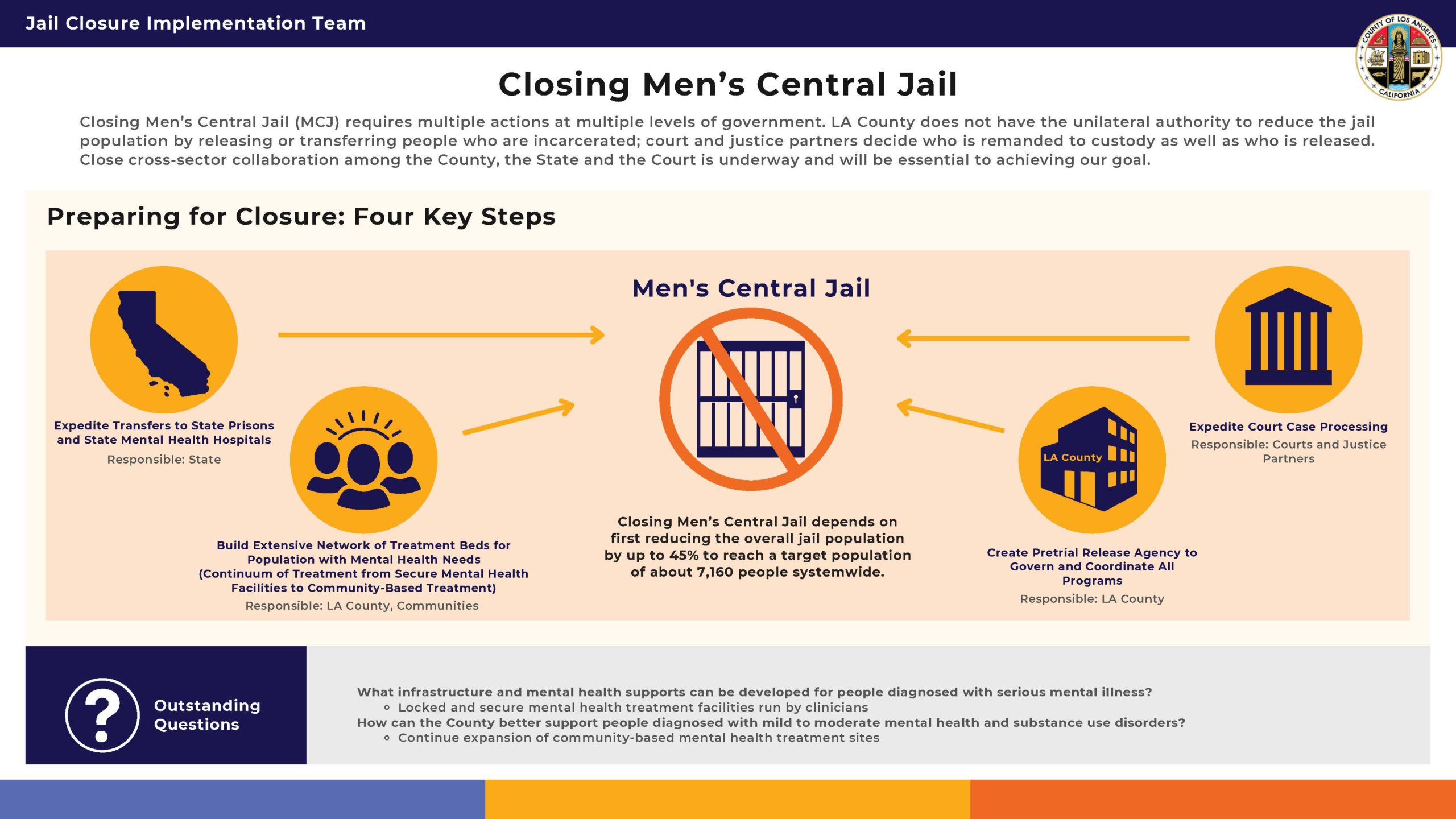
Our Mission
The Los Angeles County jails are filled with people struggling with homelessness, poverty, mental illness and addiction. The justice system is ill-equipped to respond to these human conditions, resulting in far too many people cycling in and out of jail, with no benefit to public safety—instead of getting the support they need to lead healthy and productive lives.
Guided by the “Care First, Jail Last” vision, the Jail Closure Implementation Team’s (JCIT) mission is to safely and methodically depopulate and eventually close Men’s Central Jail by expanding the continuum of care for individuals being diverted or released from jail, while ensuring public health and safety. This work relies on close collaboration with County departments, other Board initiatives like Alternatives to Incarceration and vested community stakeholders.

Our Progress to Date
On June 22, 2021, the Board of Supervisors approved a motion to create the Jail Closure Implementation Team to distill the various recommendations from the inventory of studies and reports concerning the closure of Men’s Central Jail and to develop actions, goals and associated timelines to safely and methodically depopulate and close the jail.
In September and October of 2021, a small and nimble County team was formed to staff JCIT, comprised of County staff who have worked extensively in the areas of law, justice reform, mental health, health services, homeless services and child welfare.
Overcrowding at the Inmate Reception Center
With the sunset of the statewide emergency bail schedule imposed during the COVID-19 pandemic, jail bookings have increased, leading to concerns about overcrowding and long wait times for processing at the Inmate Reception Center in downtown Los Angeles.
On June 28, 2022, the Board of Supervisors directed the JCIT and Alternatives to Incarceration Initiative to collaborate with the Sheriff’s Department, Correctional Health and other pertinent departments to develop a proposal for using AB109 funding to address the overcrowding.
On August 3, 2022, the JCIT offered a preliminary set of strategies for mitigating overcrowding, including hiring registry positions to fill clinical vacancies; making physical modifications to staging space in Twin Towers; adding clinical space for medical and mental health screenings and evaluations; and conducting legal analysis regarding targeted pre-trial releases of individuals awaiting trial on non-violent felony and misdemeanor charges.
The initial report is linked below. Progress on this front will be discussed in future JCIT quarterly reports to the Board.
JCIT Progress Reports
Gender Responsive Advisory Committee
Recommendations of the Gender Responsive Advisory Committee—which also includes two spirit, lesbian, gay, bisexual, questioning and transgender, gender non-conforming and/or intersex individuals as part of its target population—also inform JCIT’s work.
On October 19, 2021, the Board directed JCIT to prioritize recommendations by the GRAC to:
— Expand the community-based system of care for cisgender women and 2S-LGBQ+TGI individuals housed at Century Regional Detention Facility and the K6-G units at Twin Towers Correctional Facility;
— Contract for an updated population study of both groups; and
— Promote gender-responsive, trauma-informed services and programming in the jails.
More information on GRAC’s work can be found here:
Frequently Asked Questions
Successful closure of Men’s Central Jail (MCJ) will require a reduction of the jail population by about 6,000 people or a decrease of roughly 45% from current levels. Since early 2020, the population has been reduced by approximately 4,000 people, driven by priorities that the Jail Closure Implementation Team (JCIT) is continuing to support, including:
- The issuance of citations instead of detention for misdemeanor, non-violent and non-serious charges
- Aggressive pretrial release of individuals who were primarily charged with non-violent felonies
- Increased access to diversion programs
Successful closure of Men’s Central Jail will require a reduction of the jail population to roughly 7,160 people or a decrease of roughly 45% from current levels. To accomplish that goal, JCIT needs the cooperation of various justice, governmental and community partners.

Roughly 60% of those who now remain jailed are charged with or sentenced for committing serious or violent felonies. The number charged with felony drug or misdemeanor offenses is each less than 5%. It is estimated that half of the jail population has a mental health need, with 20% diagnosed with a serious mental illness. Approximately 5% of the custody population is awaiting placement to a mental health facility. While approximately 45% of the jail population is being held prior to trial, most of these individuals are charged with serious and violent felonies. The Court is unlikely to release these individuals into the community, particularly those in need of mental health treatment that pose a grave danger to themselves or others. Other individuals may be incarcerated based on holds from other jurisdictions or due to multiple charges, complicating the potential for release. The majority of those detained are men; women comprise roughly 10% of the jail census. Roughly 54% are Hispanic, 29% are Black, 13% are white and the remaining 4% identify with other racial and ethnic designations.
JCIT has identified several methods to reduce the jail population, including:
- Creation and implementation of a Custody Alternatives Team to recommend release, when appropriate
- Expedited court case processing to reduce the length of stays
- Consolidation and expansion of available pretrial services
- Acceleration of transfers to state hospitals and state prisons
- An increase in the number of available secure local mental health facilities
However, the Board of Supervisors and the CEO do not have authority over the Court or other entities that can directly influence jail release or other court processes. The options above will take time as they depend upon building a track record of success and establishing partnerships among the Court, justice partners (e.g., District Attorney, Public Defender, Alternate Public Defender and Sheriff), community-based organizations, and County programs available to support people outside of custody.
Decreasing the jail population by 45% is roughly equivalent to the release of 100% of the individuals currently being held pretrial. While the Court is ultimately responsible for making release decisions, it is unlikely to release large numbers of individuals held on serious or violent felony charges—which includes the majority of people currently held in the County jail system—without significant investment and expansion of the infrastructure available to support a person if released.
The County can provide options to support Court release from custody by offering diversion programming and establishing a Custody Alternatives Team (CAT). A CAT would allow justice partners to build consensus around cases to present to the Court for release consideration.
Based on reasonable case review workloads 1 and the probability of release, 2 the County could expect the release of 40-120 individuals per year through a CAT, though this number could increase with dedicated staff and additional resources. This represents small incremental gains against the goal of reducing the jail population by roughly 6,000 people in total.
Additional progress could be made by expediting court processing, reducing court continuances, and swiftly dispositioning backlogged cases. The 2021 JFA Institute report estimated this could result in a reduction of about 2,000 jail beds. This work is outside the County’s control and relies on the Court.
Rapid transfers to both state prisons and state hospitals are critical to maintaining a lower population. State prison transfers have resumed, while the number of people awaiting transfer to state hospitals has grown by more than half since September 2021. Currently, nearly 700 individuals await state hospital transfer.
About 20% of the jail population has significant to severely debilitating mental health needs that would require treatment in secure mental health facilities if they were to qualify for release.
To fund these beds, the County will need to rely on Medi-Cal funding that cannot be used for facilities with more than 16 beds without receiving the appropriate waiver. Absent a change to federal Medicaid regulations (which would require an act of Congress) or support to build a locked, County-operated mental health treatment facility, it is estimated that between 80-100 such small facilities would need to be built to accommodate this population.
Based on the County’s experience in other similar projects, securing locations to establish such facilities could be sensitive and require significant time, community and stakeholder engagement and education, as well as financial investment.
To fulfill the County’s goal of safely depopulating and closing MCJ as soon as possible, it will be necessary to:
- Continue facilitation of state prison and state hospital transfers
- Work with the Court and justice partners to persuade them to expedite criminal case processing
- Implement a CAT to build consensus around recommendations for release
- Build locked and secured mental health treatment facilities run by clinicians
- Lobby to have the Medicaid Institutions for Mental Disease exclusion waived
- Facilitate transfers between existing County jail facilities with suitable vacant space Continue development of a consolidated pretrial services agency to increase access to available reentry services, including expansion of pre-plea and rapid diversion programs and increased workforce development support
As the County continues to make progress in the efforts identified above, a more reasonable and accurate timeline to safely accomplish MCJ closure will develop.

